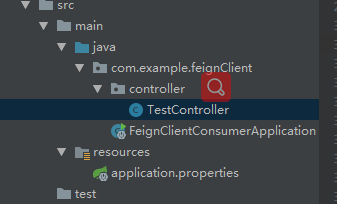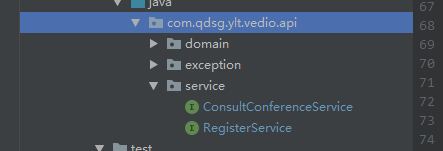1.首先我们将生产者的接口暴露出来,一般是作为独立的对外接口,写在一个项目里。将对外的接口打包。
当然还有我们的pom文件依赖
<?xml version="1.0" encoding="UTF-8"?>
<project xmlns="http://maven.apache.org/POM/4.0.0"
xmlns:xsi="http://www.w3.org/2001/XMLSchema-instance"
xsi:schemaLocation="http://maven.apache.org/POM/4.0.0 http://maven.apache.org/xsd/maven-4.0.0.xsd">
<modelVersion>4.0.0</modelVersion>
<groupId>com.qdsg.ylt</groupId>
<artifactId>ylt_api</artifactId>
<version>0.0.1-SNAPSHOT</version>
<packaging>pom</packaging>
<description>所有对外api接口由该项目负责</description>
<modules>
<module>vedio_api</module>
</modules>
<parent>
<groupId>org.springframework.boot</groupId>
<artifactId>spring-boot-starter-parent</artifactId>
<version>2.0.4.RELEASE</version>
<relativePath /> <!-- lookup parent from repository -->
</parent>
<dependencyManagement>
<dependencies>
<dependency>
<groupId>org.springframework.cloud</groupId>
<artifactId>spring-cloud-dependencies</artifactId>
<version>Finchley.SR1</version>
<type>pom</type>
<scope>import</scope>
</dependency>
</dependencies>
</dependencyManagement>
<dependencies>
<dependency>
<groupId>org.springframework.boot</groupId>
<artifactId>spring-boot-starter-test</artifactId>
<scope>test</scope>
</dependency>
//注意该依赖一定要放在spring-cloud-starter-openfeign依赖的上边,不然消费方可能会出现一些问题
<dependency>
<groupId>org.springframework.cloud</groupId>
<artifactId>spring-cloud-starter-netflix-eureka-client</artifactId>
</dependency>
<dependency>
<groupId>org.springframework.cloud</groupId>
<artifactId>spring-cloud-starter-openfeign</artifactId>
</dependency>
</dependencies>
</project>
2.还有就是消费者,如何调用接口,
我们将打好的jar包引入到消费者的项目里边去,通过pom引入,(接口打包的时候会有相应的坐标)。
消费者的包结构

这个是消费者的启动类
@SpringBootApplication(scanBasePackages = {"com.qdsg","com.example"})
@EnableEurekaClient
@EnableFeignClients(basePackages= {"com.qdsg"})
public class FeignClientConsumerApplication {
public static void main(String[] args) {
SpringApplication.run(FeignClientConsumerApplication.class, args);
}
}
看到启动类上扫面了两个包,一个是该项目的扫描,一个是引入jar的包扫描,你也可以简单来写(@SpringBootApplication(scanBasePackages = {"com"}))
还有就是@FeignClient注解的扫描,扫描的是对外接口所在的包。如下:

消费者调用提供的jar包(使用注入的方式)



这样就可以调用我们对外提供的接口了,但是要保证你的项目启动并且注册到eureka上。
如何注册呢,配置如下
eureka:
client:
service-url:
defaultZone: #这里是服务注册地址
register-with-eureka: true
fetch-registry: false
instance:
instance-id: 192.168.1.88
prefer-ip-address: true
lease-renewal-interval-in-seconds: 1
lease-expiration-duration-in-seconds: 5
下面就是对外提供的接口
对外的接口


异常回调


当然还有用到的实体类都要暴露出来
消费者配置
##配置项目名字
eureka:
client:
service-url:
defaultZone: http://119.3.18.49:8071/eurekaservers/eureka/
fetch-registry: true
register-with-eureka: false
# #feign 对hytrix的支持
feign:
hystrix:
enabled: true
ribbon:
ReadTimeout: 15000
ConnectTimeout: 60000
hystrix:
command:
default:
execution:
isolation:
thread:
timeoutInMilliseconds: 20000
加上最后一个配置熔断才会有作用







 本文深入探讨了微服务架构下服务接口暴露、消费者调用、依赖引入及配置注册等关键步骤,详细介绍了如何通过Maven管理项目依赖、引入Spring Cloud组件进行服务发现、使用Feign实现远程调用,以及配置Eureka服务注册中心的过程。同时,文章还涉及了异常回调机制和熔断支持的实现,确保服务间的稳定交互。
本文深入探讨了微服务架构下服务接口暴露、消费者调用、依赖引入及配置注册等关键步骤,详细介绍了如何通过Maven管理项目依赖、引入Spring Cloud组件进行服务发现、使用Feign实现远程调用,以及配置Eureka服务注册中心的过程。同时,文章还涉及了异常回调机制和熔断支持的实现,确保服务间的稳定交互。
















 6603
6603

 被折叠的 条评论
为什么被折叠?
被折叠的 条评论
为什么被折叠?








